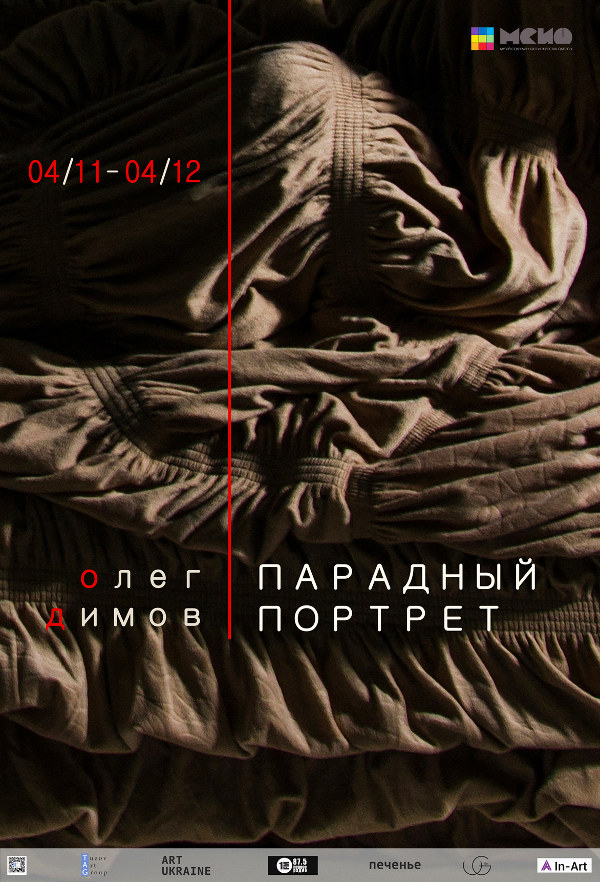Oleg Dimov. Parade portrait
08.11.2016 2023-11-15 14:42Oleg Dimov. Parade portrait

From 4.11 to 4.12.16 the Museum of Odesa Modern Art will exhibit Oleg Dimov’s project ‘Parade Portrait’.
Oleg Dimov, although young, has managed to convince everyone of the validity of his interest and deep understanding of the problem of human loneliness in the modern world. The new exhibition is about this again.
Portrait implies a more or less radical separation of the object from its surroundings. Parade – it requires it. In his works Oleg multiplies the effect by removing any visual features of the background. The object becomes alone in its parade-like grandeur.
However, the paradox of Dimov’s works is that we do not know whose portraits they are. After all, the portrayed people(?) are covered with drapery! What for?
A desire to hide from the annoying attention to the celebrity?
Maybe it’s an attempt to add mystery? After all, the figures under the drapery are not trying to blend in with their surroundings.
Or is it arrogant aloofness – unwillingness to see others?
Today, drapery has a new interpretation – the veil. A tool of self-identification and, to some extent, self-isolation from society.
Loneliness, alienation, mystery – these are very modern categories.
Their subtle understanding underlines the modernity and level of the artist Oleg Dimov, whose exhibition will open at the ISIO on 4 November 2016 at 18.00.
In my search for a plastic motif, I always stop at the concentration of an object or a person as a unit, or at their absence at all, and I get only a laconic interior or exterior as a filling for a creative work. As a result, in many of my works, and later in my projects, the ideology of loneliness and separateness can be traced. This process and its result can be attributed to the intuitive principle of the artist’s work.
If we talk about conscious ideological and visual actions, then in the Parade Portrait project I began to feel more synchronised.
Focusing on the conceptual rationale of the “parade exhibition”, I would like to point out two characteristic phenomena of disunity in the contemporary world. Firstly, today’s society lives without unifying ideologies that could give it directions towards common goals. Today man is democratic and at liberty to live according to his own programme of action. Secondly, today a person, without leaving home, thanks to the Internet can earn money, order the necessary things for his existence, get answers to questions, learn, communicate… And moreover, to live in a virtual world, without contact with reality, and what is impossible not to mention – to feel “complete” in the environment of “everything” and “everyone”.
“Parade portrait” in my performance is an ironic way to emphasise status and a kind of apotheosis of isolation. It is a portrait of an individual representing and exalting himself in this state. A kitsch of dissociation. A “celebration” of loneliness.
О. Dimov
For four centuries of Western thought, the fold has acted as the ideal figure of description of every complexity. From Leibniz’s whimsical rocaille and differential calculus to Merleau-Ponty’s constitution of the relationship between the internal and the external, creating “depth and density returned to itself”. The simplicity of this image allows it to be elevated to any degree of abstraction.
The Deleuzian fold avoids a straightforward tension that is always artificial and violent. The fold multiplies, piles one on top of the other. It hides secret ruptures, creates a continuous connection through folding. The fold is dynamic and unique. For Vidal, the fold is biomorphic. It “lives, breathes, is enlivened by peristalsis, sinuosities, a giant gut, sea ripples, a landscape of moving topography”.
The wrinkle runs down the curl of the wig, runs down the fold of the fur-lined velvet, gets lost in the curl of the furniture, clings to the bent volute of the column until it breaks into a straight perspective. Thackeray’s caricature exposes Rigaud’s ceremonial portrait, separating the two solitudes – the little man and the Olympian deity.
To speak of the individuality of the former and the latter is to speak of loneliness, of the distance separating man from the other beings around him. The complexity, the collapsibility of alienation is only exacerbated by the multiplicity of representations. Selfies of the naked king, the eternal loner, the singa.
Kirill Lipatov.
INFORMATION ABOUT THE EXHIBITION AND CONTACTS:
The exhibition will open at the Museum of Odesa Modern Art on 4 November 2016 at 6 p.m.
